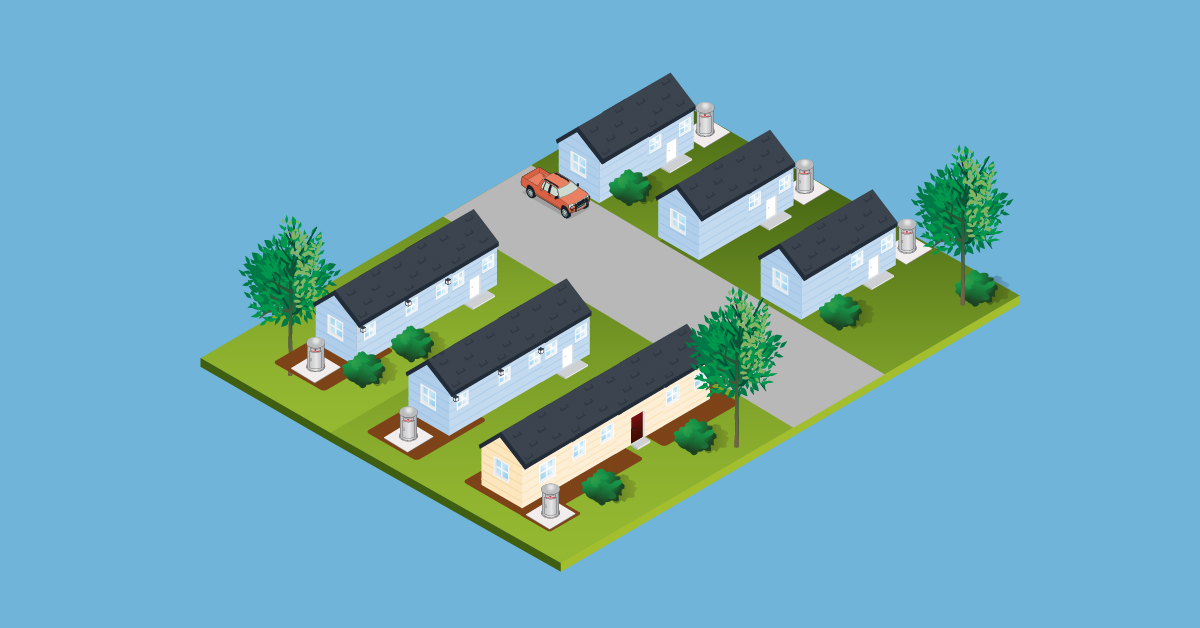CATEGORIES:
Ensuring Tornado Safety in Mobile Homes: Secure Shelter Solutions
May 15, 2023

Living in a mobile home can bring many benefits, like affordability and flexibility. Maybe you’ve found the perfect plot of land and you aspire to build your dream home. But before you can get to it, you need a less expensive place to stay on your property. Or, maybe you want the community and amenities that come from living in a mobile home park or an upscale residential village with playgrounds, swimming pools, and community centers. There are many reasons you might choose to live in a manufactured home.
However, when it comes to severe weather events like tornadoes, concerns about living in a mobile home quickly arise. There are many myths surrounding tornadoes, but it is a fact that being inside a mobile home when a tornado strikes is not safe.
At Survive-A-Storm, we understand the importance of providing secure shelter options for mobile home residents. And, you don’t have to give up your dream. There are tornado shelters specifically tailored to address the needs and concerns of those living in mobile homes, offering peace of mind during tornado threats.
Secure Tornado Shelter Options for Mobile Homes
- Underground Storm Shelters: One option for tornadoes is an underground storm shelter. Because they are installed below the ground they offer natural protection from wind and flying debris, and they typically have reinforced doors. With the ground excavated, the shelter can be lowered into the hole and then backfilled around the shelter. Some details may vary depending on the model. (For example, our GarageCube is backfilled with concrete.) It’s important to note that underground shelters make accessibility more difficult for those with limited mobility since stairs are required. They are also not feasible in all areas, due to water levels, ground/soil conditions and the fact that they are permanent. (If you don't own the land, installing a permanent underground tornado shelter may not make much sense.)
- Above-Ground Tornado Safe Rooms: If an underground storm shelter is not feasible for your situation, due to accessibility or property limitations, an above-ground safe room is an excellent alternative. These safe rooms are specially engineered to withstand tornado-force winds and can be built adjacent to the mobile home itself. They can be built inside of outdoor buildings, if placed directly on a suitable concrete slab and anchored into place. Since they are ground level, they don’t require stairs, so accessibility is not an issue.
- Above-Ground Tornado Shelters: For mobile home residents seeking flexibility and mobility, some tornado shelters provide all the safety mentioned above, in a convenient solution that is easily transportable if/when you relocate your home. Tornado shelters, like Survive-A-Storm’s Twister Pod, are made of industrial-strength steel and equipped with secure locking mechanisms. They are anchored to an outside slab of concrete and will keep you safe, even in an EF5 tornado.
- Community Storm Shelters: In situations where individual shelter options are not possible, seeking out community storm shelters is a viable alternative. Many mobile home parks or local community centers have designated storm shelters that are designed to accommodate multiple people during severe weather events. If your tornado safety plan involves using a community shelter, it is important to familiarize yourself with the nearest community shelters and have an emergency plan in place to ensure timely access and safety.
Tornado Shelter Industry Standards Are Important
It’s important to look for a manufacturer who is a member of the National Storm Shelter Association, since NSSA members must adhere to industry standards. Here are a few of the consumer benefits of working with a manufacturer who is a member of the NSSA.
- Design and Construction: Standards may include guidelines for the design and construction of tornado shelters, such as requirements for structural integrity, materials, anchoring systems, ventilation, and accessibility. They may also specify parameters for sizing, clearances, and weight limits.
- Wind Resistance: Standards often address the wind resistance capabilities of tornado shelters, including the ability to withstand specific wind speeds and pressures associated with tornadoes. This can encompass the shelter's structural design, anchoring methods, and door integrity.
- Debris Impact Protection: Guidelines cover the shelter's ability to withstand impacts from flying debris, which is a significant hazard during tornadoes. This includes criteria for the strength and durability of shelter components, such as walls, roofs, and doors.
- Testing and Certification: NSSA standards typically require manufacturers to subject their tornado shelters to testing protocols that simulate tornado conditions. Testing may involve various factors like wind pressures, debris impact, water resistance, and structural performance. Certification from accredited testing facilities is necessary to validate compliance with these standards.
- Installation: Standards may also include recommendations or requirements for proper installation practices to ensure the shelter's effectiveness.
Tornado Safety and the Naysayers
“What happens when a tree blocks the exit?”
“The only safe place to be is underground!”
“I’d rather just wait it out than get into that coffin.”
We’ve seen our share of comments on social media. But, to be clear, tornado shelters aren’t built to look pretty and it’s very difficult to show in a single photo on social media, or a blog post that they are spacious enough for the small amount of time that you might spend in them for your own safety. So, does an underground shelter look like a coffin? Maybe - only you can be the judge of that, but is it safe? Definitely.
In areas where the water table is high, or that are prone to flooding, like coastal areas, being underground during a tornado is not feasible. And, sometimes, due to accessibility issues, getting up and down stairs is difficult. For these reasons, above-ground tornado shelters are a viable option. And, they're just as safe as underground tornado shelters.
Above-ground tornado shelters are often the only thing left standing after a tornado, so naturally, it IS possible that the door could be blocked. An above-ground tornado shelter can be designed with doors that swing in either direction − in or out. So, it is possible that a tree or other debris could block the exit. In this case, there are a few options. The first is a door jack to physically remove the obstruction and push the door open. The second is GPS location tracking. It requires a subscription, but here’s how it works:
If a tornado strikes your area, we attempt to contact you to check how you are and if you need assistance. If we are unable to contact you or your emergency contacts, we contact emergency crews with the exact GPS coordinates of your shelter and ask them to check your shelter location and provide assistance.
And lastly, in regard to debris obstruction, some models of above-ground tornado shelters have alternative exits or escape hatches.
Empowering Mobile Home Residents: Taking Charge of Tornado Safety
Living in a mobile home does not mean compromising your safety during tornado threats. By exploring different shelter options tailored to mobile home residents, you can significantly enhance your protection and peace of mind. Whether you opt for an underground storm shelter, above-ground safe room, above-ground tornado shelter, or rely on community storm shelters, the key is to prioritize your safety and be prepared for emergencies.
Remember to stay informed about weather alerts, develop an emergency plan, and ensure your chosen shelter meets NSSA testing standards. With the right tornado shelter solution, you can confidently face tornado threats while living comfortably in your mobile home.
To start making your mobile home plan for tornadoes, contact Survive-A-Storm today.




